Lockheed TriStar (RAF)
| TriStar | |
|---|---|
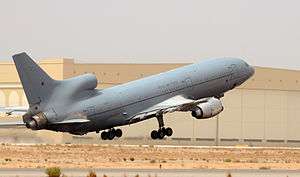 | |
| ZD951, an RAF TriStar K1 tanker, taking off in 2008 | |
| Role | Strategic tanker/transport |
| Manufacturer | Lockheed Corporation |
| First flight | 16 November 1970 (L1011) |
| Introduction | 1984 |
| Retired | 2014 |
| Primary user | Royal Air Force |
| Produced | 1979–1984 |
| Number built | 9 conversions |
| Developed from | Lockheed L-1011 |
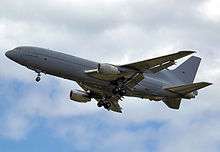
The Lockheed TriStar was an air-to-air tanker and transport aircraft in service with the Royal Air Force (RAF). All were converted civilian Lockheed L-1011-500 TriStar airliners—previously operated by British Airways and Pan American World Airways—and entered service with the RAF in 1984.
The converted aircraft were purchased following the Falklands War, after a requirement for additional air-to-air refuelling operations had been identified. Of the nine in service, two were tankers (K1) with passenger space and also limited space for cargo loaded aft of the main deck; three were solely transport aircraft (C2); and the remaining four (KC1) could be used for either of the two roles. The TriStars formed the air-to-air refuelling fleet of the RAF until replaced by the Airbus A330 MRTT under the Future Strategic Tanker Aircraft (FSTA) programme.
The TriStar fleet was operated by No. 216 Squadron of RAF Brize Norton in Oxfordshire. 216 Squadron was officially disbanded on 20 March 2014 and flew its last sorties with the TriStar on 24 March 2014.[1]
Design and development

The Royal Air Force operated nine L-1011-500s TriStars, six ex-British Airways and three ex-Pan Am.[2] The TriStars were bought in the immediate aftermath of the Falklands War to bolster the long range capability of the RAF in the transport and tanker roles, as the demands of refuelling Hercules supporting forces stationed in the Falklands was rapidly using up the fatigue life of the RAF's Handley Page Victor tankers. A requirement for at least four wide-bodied tanker/transports was drawn up. At the same time, British Airways wished to dispose of its Lockheed L-1011-500 aircraft, and so put in a joint bid with Marshall Aerospace to supply six TriStars.[3] The initial order for the ex-British Airways TriStars was placed on 14 December 1982; the three ex-Pan Am aircraft were purchased in 1984.[4] All of the aircraft served with No. 216 Squadron, based at RAF Brize Norton.
Marshall Aerospace performed the conversion of the TriStars.[2] Two of the aircraft were passenger/tanker aircraft designated TriStar K1s. Another four could operate as either tankers or passenger/cargo aircraft - these are KC1s. Three were pure passenger aircraft; two TriStar C2 and the solitary TriStar C2A. The C2A differed from the C2s in having some military avionics and a new interior.[2]
The RAF's TriStars were subject to progressive updating, including the fitting of flight deck armour and Directional Infrared Counter Measures to protect against ground fire when flying into Iraq. The aircraft were to be fitted with an updated cockpit, but this was abandoned due to the upcoming out-of-service-date.[5]
The TriStar was expected to remain in service with the RAF until the end of the 2010s, when it was scheduled to be replaced by the Airbus A330 MRTT under the Future Strategic Tanker Aircraft (FSTA) programme. However, the date was brought forward to 2014 under the Strategic Defence and Security Review of 2010. The Airtanker consortium, led by EADS, won the FSTA contract in January 2004. During doubts over the FSTA program, Marshall Aerospace offered to buy and convert some of the large number of surplus commercial TriStars as tankers, but this was rejected.[6]
Operational history
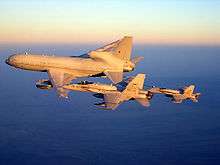
The aircraft saw service in many conflicts. Two were deployed to King Khalid International Airport, near Riyadh in Saudi Arabia during the 1991 Gulf War as tankers, with the rest used for transport between the Persian Gulf and United Kingdom. The two aircraft deployed received nose art naming them Pinky and Perky. During the 1999 Kosovo War, TriStars deployed to Ancona in Italy, again as tankers, with four aircraft involved. TriStars joined VC10s in the air-to-air refuelling role for Operation Veritas (Afghanistan), during which they provided aerial-refuelling for US Navy aircraft. The RAF deployed four TriStars during Operation Telic to Bahrain.
TriStar air-to-air refuelling aircraft supported the British air strikes on Libya on 19–20 March 2011 as part of the coalition operations to enforce UN Resolution 1973.[7]
Aircraft on Display
TriStar KC-1 N405CS is on display at Bruntingthorpe Aerodrome,[8] where it is in the process of being restored to an airworthy condition. It is joined by two other TriStars which are also being restored in hopes of an eventual sale.
Variants
- TriStar K1
- Conversion of former British Airways TriStar 500s for tanker/transport/cargo role (not fitted with a cargo door), two aircraft. Additional fuel tanks of 100,000 lb capacity fitted in forward and aft baggage holds. Main cabin palletised and quickly configurable in mixed passenger / freight mode to seat up to 187 passengers with baggage stored forward end main deck. Two Flight Refuelling Mk 17T Hose Drum Units in underside aft rear fuselage.
- TriStar KC1
- Conversion of former British Airways TriStar 500s for tanker/cargo/transport role, four aircraft.
- TriStar C1
- Former British Airways TriStar 500s operated as passenger aircraft before tanker conversion.
- TriStar C2
- Former Pan Am TriStar 500s operated as passenger aircraft, with capability for carrying cargo and also Aeromed, two aircraft.
- TriStar C2A
- One former Pan Am TriStar 500 operated as passenger aircraft, different avionics to the two C2s.
Operators
Specifications (TriStar K1)
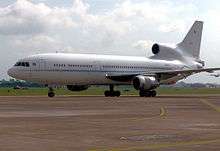
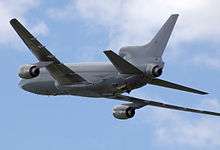
Data from The International Directory of Military Aircraft,[2] RAF TriStar page[9] Airliners.net[10]
General characteristics
- Crew: 4 (1 captain, 1 co-pilot, 1 air engineer, 1 Air Loadmaster)
- Capacity: 187 passengers (250 on C variant)[11]
- Length: 50.05 m (164 ft 3 in)
- Wingspan: 50.09 m (164 ft 4 in)
- Height: 16.87 m (55 ft 4 in)
- Wing area: 329.0 m² (3540 ft²)
- Empty weight: 105,165 kg (242,684 lb)
- Max. takeoff weight: 245,000 kg (540,000 lb)
- Powerplant: 3 × Rolls-Royce RB.211-524B turbofans, 50,000 lbf (222.4 kN) each
- Maximum Fuel Load: 136,080 kg (300,000 lb)
Performance
- Maximum speed: Mach 0.90
- Cruise speed: Mach 0.83 (483 kn, 894 km/h)
- Range: 4,200 nmi (7,785 km) with maximum passenger payload
- Service ceiling: 43,000 ft (13,000 m)
- Rate of climb: 2,820 ft/min (14.3 m/s)
See also
- Related development
- Aircraft of comparable role, configuration and era
- Airbus A330 MRTT
- Boeing KC-767
- EADS/Northrop Grumman KC-45
- McDonnell Douglas KC-10 Extender
- Vickers VC10
- Related lists
References
- Notes
- ↑ Hoyle, Craig (2014-03-24). "RAF TriStars to fly final sortie". Flight International. Retrieved 2014-03-25.
- 1 2 3 4 Frawley, Gerard (2002). The International Directory of Military Aircraft, 2002-2003. Fyshwick, ACT, Australia: Aerospace Publications Pty Ltd. p. 44. ISBN 1-875671-55-2.
- ↑ Prothero Air International March 1991, pp. 129–130.
- ↑ Air International December 1985, p.271.
- ↑ Airforces Monthly, January 2013, P.9
- ↑ Winchester Air International January 2009, p.53.
- ↑ Military Operations news (20 March 2011). "Updated: British Armed Forces launch strike against Libyan air defence systems". Ministry of Defence (United Kingdom). Retrieved 20 March 2011.
- ↑ "Planepictures.net search: Airline: CSDS Aircraft Sales and Leasing". www.planepictures.net. Retrieved 2016-11-12.
- ↑ "RAF TriStar page". Raf.mod.uk. 2012-04-25. Retrieved 2012-09-23.
- ↑ Lockheed L-1011-500 page, airliners.net.
- ↑ "Tristar". RAF. 2012-04-25. Retrieved 2012-09-23.
- Bibliography
- Prothero, R.M. "Tristar:The answer to an operational requirement". Air International, March 1991, Vol 40 No. 3. pp. 128–134.
- "TriStar Tankers...The RAF Goes Widebody". Air International, December 1985, Volume 29, No. 6. Bromley, UK: Fine Scroll. pp. 271–277, 309.
- Winchester, Jim. "Aircraft of the RAF - Part 9 Tristar". Air International. January 2009, Vol 76, No 1. pp. 50–53.
- Yenne, Bill, Lockheed. Crescent Books, 1987.
External links
| Wikimedia Commons has media related to Lockheed TriStar (RAF). |